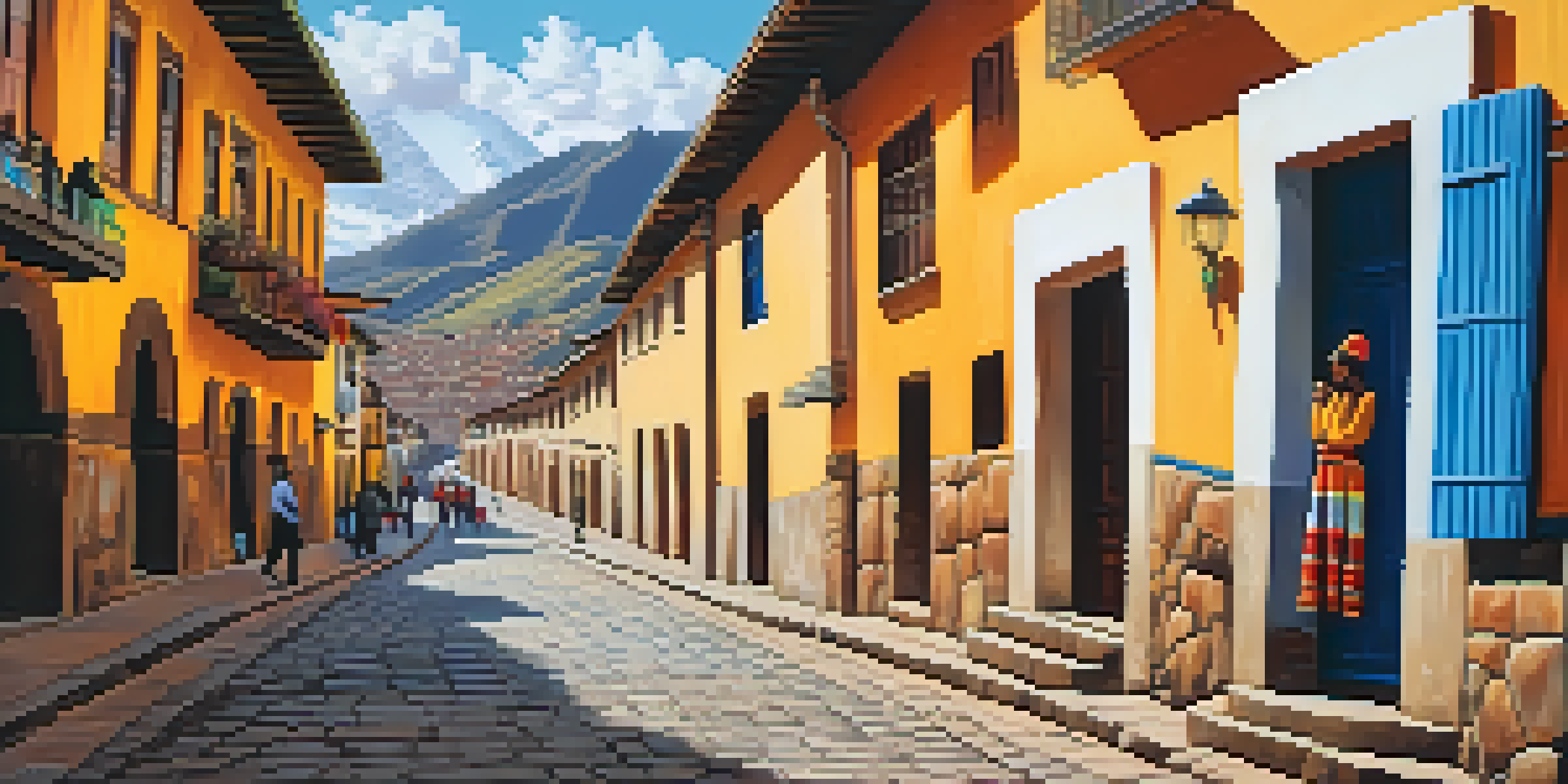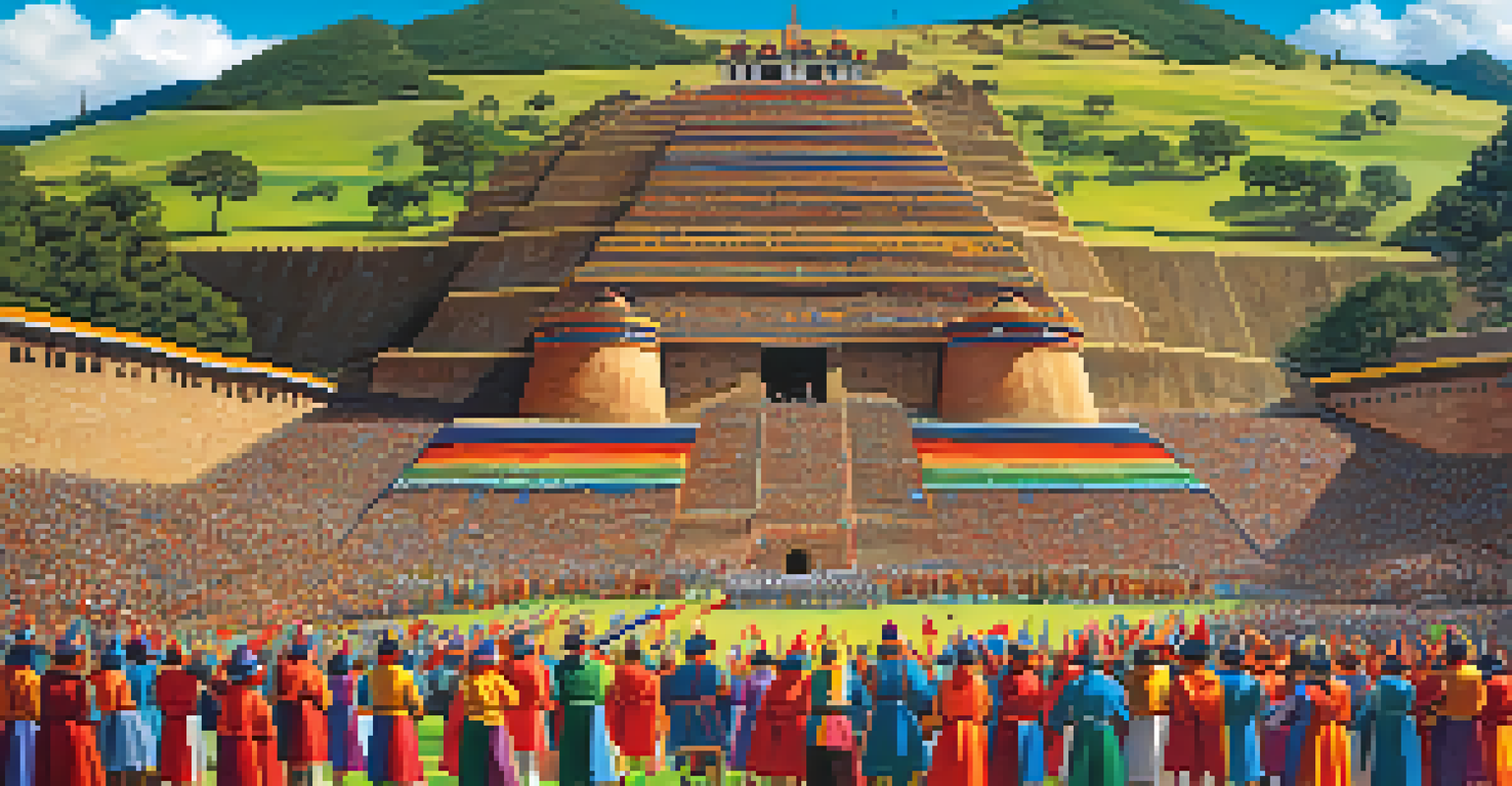The Rise of Urban Tourism in Cusco: A Cultural Perspective

Understanding Urban Tourism: A Growing Trend
Urban tourism refers to the increasing interest in exploring city life and culture. In Cusco, this trend has gained significant momentum as travelers seek immersive experiences beyond the typical tourist attractions. The vibrant streets, local markets, and historic neighborhoods invite visitors to engage with the city on a deeper level.
Traveling – it leaves you speechless, then turns you into a storyteller.
This shift from traditional sightseeing to urban exploration allows travelers to appreciate the unique cultural tapestry of Cusco. With its rich history as the former capital of the Inca Empire, the city offers a blend of ancient traditions and modern lifestyles. Tourists are now more inclined to discover local art scenes, gastronomy, and everyday life.
Furthermore, urban tourism contributes to the local economy by encouraging visitors to spend on local businesses, enhancing community engagement. As more travelers prioritize authentic experiences, the landscape of tourism in Cusco is evolving, making it an exciting destination for cultural enthusiasts.
The Cultural Tapestry of Cusco: A Unique Blend
Cusco is a city where history and modernity coexist harmoniously. The remnants of Inca architecture, such as the Sacsayhuamán fortress, stand proudly alongside colonial buildings and contemporary establishments. This unique blend is what draws urban tourists to experience the city’s layered history firsthand.

Walking through Cusco, you can encounter vibrant street art, traditional music, and local festivals that showcase the city's living culture. These experiences allow visitors to connect with the local community, fostering a sense of shared identity. For instance, participating in the Inti Raymi festival offers a glimpse into ancient rituals that are still celebrated today.
Urban Tourism Enhances Local Culture
The shift towards urban tourism in Cusco allows travelers to engage deeply with the city's vibrant culture, enhancing both visitor experiences and local community engagement.
Moreover, the culinary scene in Cusco is a testament to its cultural diversity. From street vendors serving local delicacies like ceviche to upscale restaurants offering fusion cuisine, food becomes a gateway to understanding the city’s heritage and contemporary influences. Urban tourists are increasingly seeking out these culinary experiences, enriching their understanding of Cusco's culture.
The Impact of Urban Tourism on Local Communities
As urban tourism flourishes, its impact on local communities becomes increasingly evident. On one hand, the influx of tourists creates economic opportunities for residents, from opening new businesses to providing services. This economic boost can lead to improvements in infrastructure and public services, benefiting both locals and visitors alike.
The world is a book, and those who do not travel read only one page.
However, the rapid growth of tourism can also pose challenges. Issues like overcrowding, rising living costs, and the dilution of local culture may arise if not managed properly. Communities must find a balance between welcoming tourists and preserving their unique identity, ensuring that urban tourism remains sustainable.
Engaging the local population in tourism planning is crucial for mitigating negative impacts. By involving community members in decision-making processes, cities like Cusco can develop tourism strategies that reflect the needs and aspirations of residents. This collaborative approach fosters a sense of ownership and pride in both the cultural heritage and the tourism industry.
Cultural Festivals: A Magnet for Urban Tourists
Cultural festivals in Cusco serve as a significant draw for urban tourists seeking immersive experiences. Events like Inti Raymi and the Feast of Corpus Christi not only celebrate local traditions but also attract visitors from around the globe. These festivals showcase Cusco's vibrant culture and offer tourists an opportunity to participate in age-old rituals.
During these celebrations, tourists can engage with locals, taste traditional foods, and enjoy live performances that highlight the city’s rich artistic heritage. Such interactions foster cultural exchange and help bridge the gap between visitors and residents, creating lasting memories for both parties.
Sustainable Practices Are Essential
As urban tourism grows, prioritizing sustainable practices is crucial to preserve Cusco's cultural heritage and ensure positive impacts on the local community.
Moreover, these festivals often have economic benefits for the community as well. Local artisans and vendors have the chance to showcase their products, giving them exposure and income opportunities. This symbiotic relationship between tourism and local culture enriches the overall experience for urban tourists while supporting the community.
The Role of Technology in Urban Tourism
Technology has transformed the way urban tourists explore cities, including Cusco. With the rise of travel apps and social media, visitors can easily discover local attractions, restaurants, and events at their fingertips. This accessibility enhances the overall travel experience, enabling tourists to plan their itineraries according to their interests.
Additionally, virtual tours and augmented reality experiences offer an innovative way to engage with Cusco's history. For instance, visitors can use their smartphones to access information about historical sites as they explore the city, making their experience more interactive and educational. This tech-savvy approach resonates with a younger audience, further boosting urban tourism.
However, it’s essential to strike a balance between technology and authentic experiences. While apps can enhance travel, nothing can replace the value of personal interactions and firsthand cultural immersion. Ultimately, technology should complement the urban tourism experience in Cusco, rather than overshadow its rich cultural heritage.
Sustainable Urban Tourism: A Path Forward
As urban tourism continues to rise in Cusco, the emphasis on sustainability becomes more crucial. Tourists are increasingly seeking eco-friendly options, from accommodations to transportation. This shift encourages businesses to adopt sustainable practices, benefiting both the environment and the local community.
Sustainable urban tourism also involves promoting responsible travel behaviors among visitors. Educating tourists about respecting local customs, supporting local businesses, and minimizing their environmental footprint can lead to a more positive impact on Cusco. This awareness fosters a sense of responsibility and stewardship among travelers.
Technology Transforms Travel Experiences
The integration of technology in urban tourism enriches visitors' experiences by making local attractions and cultural information more accessible.
Local authorities and tourism organizations play a vital role in this transition towards sustainability. By implementing policies that prioritize environmental conservation and cultural preservation, Cusco can ensure that future generations can enjoy its rich heritage. Embracing sustainable practices will not only enhance the tourist experience but also safeguard the city's cultural legacy.
Looking Ahead: The Future of Urban Tourism in Cusco
The future of urban tourism in Cusco holds exciting possibilities as it continues to evolve. With its unique cultural offerings, the city is poised to attract an even broader audience of travelers eager to explore its rich history and vibrant community. As more visitors seek authentic experiences, Cusco's potential as a cultural tourism hub will only grow.
However, this growth must be managed thoughtfully to preserve the integrity of the city's culture and environment. Engaging local communities and integrating their voices into tourism development will be essential for achieving a sustainable future. By fostering collaboration, Cusco can create a tourism model that benefits both visitors and residents.

Ultimately, the rise of urban tourism in Cusco presents an opportunity for cultural exchange and economic growth. By embracing its cultural heritage and prioritizing sustainable practices, Cusco can continue to thrive as a destination that offers enriching experiences for travelers and a vibrant life for its residents.